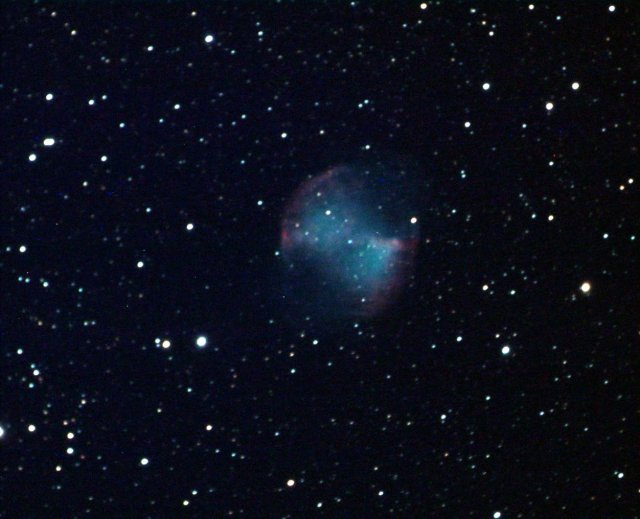More dying suns
 Before my premature bug-out due to severe weather this weekend, I did manage to do some imaging. Sticking with the theme related to the Ring nebula photos posted here another bright summer planetary nebula M27 - the Dumbbell nebula was the target on Saturday night.
Before my premature bug-out due to severe weather this weekend, I did manage to do some imaging. Sticking with the theme related to the Ring nebula photos posted here another bright summer planetary nebula M27 - the Dumbbell nebula was the target on Saturday night. This particular image, another LRGB, has the luminance (L) channel made up of 10, 30 second images (the best of 30 images taken) for a total exposure time of 5 minutes. The RG and B channels are each stacks of 6, 30 second images and provide the colour information.
Now I probably should have mentioned in the Ring nebula article that planetary nebulae are not actually planets, but are images of dying stars. They are called planetary nebula due to the fact that in the telescopes of the 1800's when they were first observed, they looked like planetary disks. What they are in reality is the cast off outer atmosphere of a star around the size of our own Sun. The star has used up it's hydrogen in the core and has started to fuse helium and other elements causing it to blow off the outer layers of the star. What will be left is a white dwarf star, the burnt out cinder that was the star's core (you can see this central star in the M27 image above). Glowing white hot, it will take billions of years to cool down. In essence when we look at planetary nebulae, we are looking at the fate of our own star, the Sun and the ultimate end of the world. Don't fret though, the Sun still has about 5 billion years left to go on the main sequence before it begins the process of dying by becoming a red giant star and then ultimately a planetary nebula and white dwarf.
The astute reader will have noticed that M57-the Ring nebula looks like, well a ring. This is what you'd expect if a spherical star blew off it's atmosphere as a sphere of gas. Since this blown off gas is a hollow sphere, it is thinest in our line of sight in the middle, while it is thicker on the edges making it look like a ring. M27- the Dumbbell nebula on the other hand looks more like a dumbbell or apple core. This is shows the wonderful diversity of planetary nebula shapes from rings to what appears to be two jets thrown off of the poles of the dying star. The mechanism that causes these differences isn't yet fully understood and is, as they say an area of active research.
We do know that planetary nebulae are a very short lived phenomenon in that their expansion causes them to dissipate into the interstellar medium over a time frame of a hundred thousand years or so, a mere blink of an eye for a star that had lived upwards of 10 billion years.

